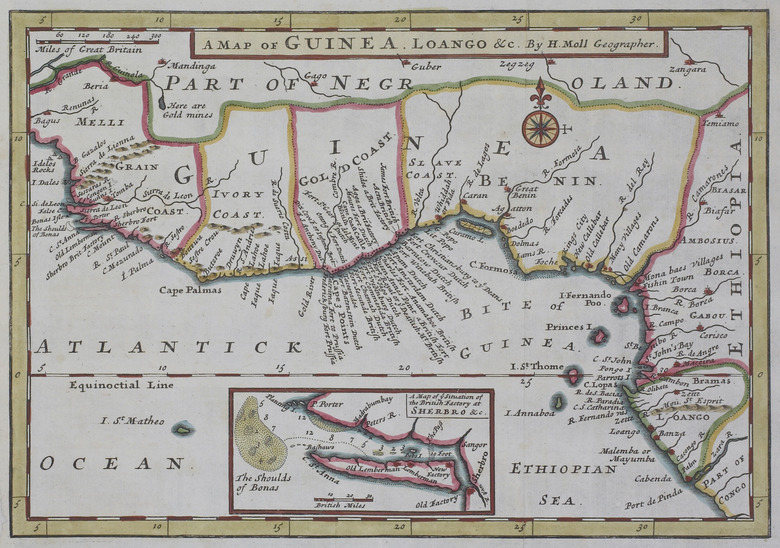The Ecosystems Of Ghana
Located in Africa along the Atlantic coast about 400 miles north of the equator, Ghana has a mostly tropical climate with alternate wet and dry seasons. The northern part of the country has a rainy season from April to October and is dry and dusty from November through March. The southern half of Ghana has rain from April to July and from September through November. Ecosystems in north Ghana are Guinea savannah and Sudan savannah. Southern Ghana contains deciduous forest, moist evergreen forest, wet evergreen forest and coastal savannah.
Coastal Savannah
Coastal Savannah
The dry coastal savannah is about 96 kilometers (60 miles) wide and contains grasslands studded with occasional trees. Seasonal streams and the Volta River exit to the Gulf of Guinea, the part of the Atlantic Ocean next to Ghana, and there are lagoons along the coastline. Waters contain fish important in the economy, and crocodiles live in larger rivers. Forested thickets occur along the streams and river, and mangrove forests and swamps accompany the coastal lagoons. Natural habitat has been cleared for farming, which is a major rural economic activity. The grasslands support livestock grazing.
Interior Savannahs
Interior Savannahs
Sudan savannah grows in the northernmost area of Ghana. In the far north, the savannah consists mostly of grass, with few or no trees and shrubs. Farther south, as Sudan savannah changes into Guinea savannah, trees become more numerous, finally changing into Guinea savannah, which is a woodland savannah that combines grassland with numerous trees and fire-resistant shrubs. Large animals such as elephants and lions used to roam the savannahs, but are now found mostly in nature reserves. About 60 percent of the annual rainfall comes in July to September, with often very heavy, erosion-causing downpours. About 70 percent of the people in northern Ghana are farmers, and they raise yams, maize, rice, tomatoes, groundnuts and Guinea corn.
Deciduous Forests
Deciduous Forests
The greater part of southern Ghana is deciduous forest. This drier forest type grows between the northern savannahs and the wetter southwestern tropical evergreen forests. Much of the land has been cleared for agriculture, with cocoa the most important export crop. Ghana is the world's third largest producer of cacao. Cotton and oil palms are also cultivated. Food crops include plantain, cassava, vegetables, maize and groundnuts. Forest animals include hyenas, monkeys, wild pigs and poisonous snakes such as cobras, horned adders and puff adders.
Evergreen Forests
Evergreen Forests
Ghana's tropical rainforest has been greatly reduced by logging and clearing land for agriculture. There are about 8.5 million hectares (21 million acres) of closed rainforest areas in the southwestern part of Ghana, with moist evergreen forest predominating in the more northern part and wet evergreen forest closer to the ocean. Well-conserved rainforest has only 1.8 million hectares (4.4 million acres), with the remainder fragmented and threatened by illegal logging, harvesting trees for the wood-carving industry, and poachers killing animals for the bush-meat trade. Valuable forest trees include ebony, teak and mahogany. Ghana's rainforests contain 728 bird species and about 225 mammal species.
References
- Ghana High Commission in Ottawa, Canada: Land & People
- United Nations Food and Agriculture Organization: Ghana: 1. Socio-Economic and Ecological Characteristics
- Ghanaweb: Nature of Ghana: Nature
- Ghana; Patricia Levy and Winnie Wong
- Rainforest Alliance: Community Forestry in Ghana
- World Wildlife Foundation: Threats to Ghana's Environment
Cite This Article
MLA
Csanyi, Carolyn. "The Ecosystems Of Ghana" sciencing.com, https://www.sciencing.com/ecosystems-ghana-13438/. 24 April 2017.
APA
Csanyi, Carolyn. (2017, April 24). The Ecosystems Of Ghana. sciencing.com. Retrieved from https://www.sciencing.com/ecosystems-ghana-13438/
Chicago
Csanyi, Carolyn. The Ecosystems Of Ghana last modified August 30, 2022. https://www.sciencing.com/ecosystems-ghana-13438/
